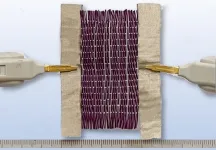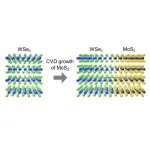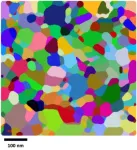(Press-News.org) A new study by researchers at Uppsala University and Uppsala University Hospital shows that men who have a neurodevelopmental disorder, such as autism and ADHD, also have a slightly increased risk of testicular cancer, or seminoma. This is the first study to show such a link, with the results to be published in the British Journal of Cancer.
Testicular cancer is the most common form of cancer in young men, and its underlying causes are still largely unknown.
“As testicular cancer can be surgically removed, thus curing the disease, it is important to seek care in time if you feel a lump in your testicle,” notes Ingrid Glimelius, Senior Consultant at the Department of Oncology at Uppsala University Hospital and Professor at Uppsala University.
The new study focused on patients with testicular cancer in Sweden. A total of 6,166 patients were included and then compared with 61,660 age-matched men without testicular cancer. Medical register data was used to investigate whether psychiatric diagnoses prior to cancer diagnosis were more common in patients with testicular cancer than in the control group.
In general, the researchers did not find an increased risk of testicular cancer in patients with a psychiatric diagnosis, but the group with a neurodevelopmental disorder in particular saw a significant increase in the risk of the seminoma type of testicular cancer.
Although the researchers found that there was an increased risk of seminoma among people with neurodevelopmental disorders the absolute risk increase was less than one percent. The risk of testicular cancer is therefore still very low even among boys and men with conditions such as autism and ADHD, and there is no need to worry if you have these diagnoses. However, the results are intriguing in terms of attempts to get closer to explaining the mechanisms of testicular cancer occurrence.
“The study also found that people with a neurodevelopmental disorder were a median of four years younger when they developed cancer and were more likely to have more advanced disease at diagnosis,” adds Glimelius.
"We also saw that people with a previous psychiatric diagnosis had a slightly increased risk of dying from their testicular cancer compared to people without a previous psychiatric diagnosis, although testicular cancer survival rates were generally very good in both groups," says Anna Jansson, doctoral student at Uppsala University and Physician at Uppsala University Hospital.
This is the first research study to provide a link between neurodevelopmental disorders and the risk of testicular cancer. Previously known risk factors include having an undescended testicle as a baby or having a father or brother with testicular cancer.
“We do not know why we are seeing a link between neurodevelopmental disorders and the risk of testicular cancer, but we believe that early life events have an impact; perhaps even as early as the foetal stage,” continues Jansson.
“Since we can see a reduced survival rate among people with a mental health issue, it is important for the health care system, the individuals in question and their families to be aware that they may also be affected by another illness, and to ensure they seek treatment if they feel a lump in their testicle. This disease can be cured in most people today,” adds Glimelius.
FACTS: Testicular cancer
* In Sweden, approximately 360 men are diagnosed with testicular cancer each year, and testicular cancer is the most common cancer among young men aged 15–35.
* The most common symptom of testicular cancer is feeling a lump in the testicle.
* The specific cause of testicular cancer is unknown, but some risk factors have been identified, such as the fact that around 10% of those affected have had surgery for an undescended testicle in childhood and that a hereditary predisposition is noted in around 1–3% of those affected. The risk is deemed most severe if you have a brother who has also had testicular cancer.
* Treatment involves surgery to remove the diseased testicle. The disease can also be cured if it has spread beyond the testicle by way of chemotherapy, which makes testicular cancer one of the most survivable cancers today.
END
Increased risk of testicular cancer in people with neurodevelopmental disorders
2023-04-24
ELSE PRESS RELEASES FROM THIS DATE:
Single CT scan in kids low risk for cancers, but 4 or more CTs increases risk
2023-04-24
For children under age 18 years, a single computed tomography (CT) scan is not associated with an increased risk of brain tumours, leukemia or lymphoma, but exposure to 4 or more scans before adulthood more than doubles the risk, according to new research https://www.cmaj.ca/lookup/doi/10.1503/cmaj.221303 in CMAJ (Canadian Medical Association Journal).
Computed tomography in children has increased worldwide in recent decades, but there is conflicting evidence about the risks of cancer from these ...
New programmable smart fabric responds to temperature and electricity
2023-04-24
A new smart material developed by researchers at the University of Waterloo is activated by both heat and electricity, making it the first ever to respond to two different stimuli.
The unique design paves the way for a wide variety of potential applications, including clothing that warms up while you walk from the car to the office in winter and vehicle bumpers that return to their original shape after a collision.
Inexpensively made with polymer nano-composite fibres from recycled plastic, the programmable fabric can change its colour and shape when stimuli are applied.
“As a wearable material alone, it has almost infinite potential ...
International study recommends replacing skull section after treatment for a brain bleed
2023-04-23
A major international trial has concluded that, where possible, surgeons should replace the removed section of the skull following surgery to treat a form of brain haemorrhage. This approach will save patients from having to undergo skull reconstruction further down the line.
The RESCUE-ASDH trial, funded by the UK’s National Institute for Health and Care Research (NIHR), involved 40 centres in 11 countries and involved 450 patients. The results of the trial are published today in the New England Journal of Medicine and are announced at the annual meeting of the American Association of Neurological ...
Achieving prevention and health, rather than more healthcare
2023-04-23
If more people have access to health insurance, we have to be sure the death rates of those with certain chronic conditions are decreasing.
This is one of the statements Gregory Peck, an acute care surgeon and associate professor at Rutgers Robert Wood Johnson Medical School, will be researching on behalf of the National Institute of Diabetes and Digestive and Kidney Diseases (NIDDK) at the National Institutes of Health.
Funded by NIH grants totaling more than $1 million through a recent two-year award from the New Jersey Alliance for Clinical and Translational Science (NJ ACTS), a Rutgers hub of the National Center for Advancing ...
Inflammation ‘brake’ gene may help reveal outcomes of kidney disease
2023-04-23
A discovery about gene variants of an inflammation ‘brake’ brings scientists a step closer to personalised treatment for patients at risk of kidney disease and kidney failure.
Researchers at the Garvan Institute of Medical Research, University of New South Wales, Sydney and Westmead Hospital, found that common genetic variants of TNFAIP3, which increase inflammation in the body, can paradoxically protect the kidneys from damage in the short term.
“We wanted to investigate whether inherited differences in how people regulate inflammation could lead to better or worse kidney health outcomes,” says Professor Shane ...
Too much insulin can be as dangerous as too little
2023-04-22
Just over a century has passed since the discovery of insulin, a time period during which the therapeutic powers of the hormone have broadened and refined. Insulin is an essential treatment for type 1 diabetes and often for type 2 diabetes, as well. Roughly 8.4 million Americans use insulin, according to the American Diabetes Association.
One hundred years of research have greatly advanced medical and biochemical understanding of how insulin works and what happens when it is lacking, but the reverse, how potentially fatal insulin hyper-responsiveness is prevented, has remained a persistent mystery.
In a new study, published in the April 20, 2023 online edition ...
From sheets to stacks, new nanostructures promise leap for advanced electronics
2023-04-22
Tokyo, Japan – Scientists from Tokyo Metropolitan University have successfully engineered multi-layered nanostructures of transition metal dichalcogenides which meet in-plane to form junctions. They grew out layers of multi-layered structures of molybdenum disulfide from the edge of niobium doped molybdenum disulfide shards, creating a thick, bonded, planar heterostructure. They demonstrated that these may be used to make new tunnel field-effect transistors (TFET), components in integrated circuits with ultra-low power consumption.
Field-effect transistors ...
How alcohol consumption contributes to chronic pain
2023-04-21
LA JOLLA, CA—Chronic alcohol consumption may make people more sensitive to pain through two different molecular mechanisms—one driven by alcohol intake and one by alcohol withdrawal. That is one new conclusion by scientists at Scripps Research on the complex links between alcohol and pain.
The research, published in the British Journal of Pharmacology on April 12, 2023, also suggests potential new drug targets for treating alcohol-associated chronic pain and hypersensitivity.
“There is an urgent need to better ...
Want to make better materials? Read between the lines. Or the “grain boundaries,” as they’re known in materials science.
2023-04-21
The orientations of these infinitesimally small separations between individual “grains” of a polycrystalline material have big effects. In a material such as aluminum, these collections of grains (called microstructures) determine properties such as hardness.
New research is helping scientists better understand how microstructures change, or undergo “grain growth,” at high temperatures.
A team of materials scientists and applied mathematicians developed a mathematical model that more accurately describes such microstructures by integrating data that can be identified from highly magnified ...
New injectable cell therapy developed by WFIRM scientists could resolve osteoarthritis
2023-04-21
WINSTON-SALEM, NC, April 21, 2023 – Wake Forest Institute for Regenerative Medicine (WFIRM) scientists have created a promising injectable cell therapy to treat osteoarthritis that both reduces inflammation and also regenerates articular cartilage.
Recently identified by the Food and Drug Administration as a public health crisis, osteoarthritis affects more than 520 million people worldwide who deal with pain and inflammation. Osteoarthritis is typically induced by mechanical or traumatic stress in the joint, leading to damaged cartilage that cannot be repaired naturally.
“Without better understanding of what drives the initiation and progression of osteoarthritis, effective treatment ...



